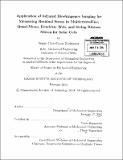Application of infrared birefringence imaging for measuring residual stress in multicrystalline, quasi-mono, dendritic web, and string ribbon silicon for solar cells
Author(s)
Castellanos Rodríguez, Sergio
DownloadFull printable version (13.50Mb)
Other Contributors
Massachusetts Institute of Technology. Department of Mechanical Engineering.
Advisor
Tonio Buonassisi.
Terms of use
Metadata
Show full item recordAbstract
One of the parameters with highest impact on photovoltaic module cost is manufacturing yield during solar cell production. Yield is, to a great extent, directly affected by the crystallization technique used to grow the substrate wafers due to its role in generating residual stresses that can lead to fracture upon wafer processing and handling. This thesis explores the nature, impact, and a method for quantifying residual stresses in silicon wafers used for solar cells. The combination of an infrared birefringence imaging technique along with a sectioning method is proposed as an approach to spatially resolve and decouple the in-plane residual stress components on four wafers originating from different growth methods. The suitability of this technique is verified, and recommendations for future expansion of this work are presented.
Description
Thesis: S.M., Massachusetts Institute of Technology, Department of Mechanical Engineering, 2014. Cataloged from PDF version of thesis. Includes bibliographical references (pages 96-102).
Date issued
2014Department
Massachusetts Institute of Technology. Department of Mechanical EngineeringPublisher
Massachusetts Institute of Technology
Keywords
Mechanical Engineering.